Natural History (Pliny)
LC Class PA6611 .A2 | | |
Original text | Naturalis Historia at Latin Wikisource | |
|---|---|---|
| Translation | Natural History at Wikisource | |
The Natural History (
The work is divided into 37 books, organised into 10 volumes. These cover topics including astronomy, mathematics, geography, ethnography, anthropology, human physiology, zoology, botany, agriculture, horticulture, pharmacology, mining, mineralogy, sculpture, art, and precious stones.
Pliny's Natural History became a model for later encyclopedias and scholarly works as a result of its breadth of subject matter, its referencing of original authors, and its index.
Overview
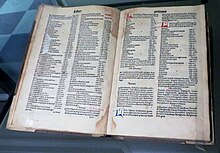
Pliny's Natural History was written alongside other substantial works (which have since been lost). Pliny (AD 23–79) combined his scholarly activities with a busy career as an imperial administrator for the emperor Vespasian. Much of his writing was done at night; daytime hours were spent working for the emperor, as he explains in the dedicatory preface addressed to Vespasian's elder son, the future emperor Titus, with whom he had served in the army (and to whom the work is dedicated). As for the nocturnal hours spent writing, these were seen not as a loss of sleep but as an addition to life, for as he states in the preface, Vita vigilia est, "to be alive is to be watchful", in a military metaphor of a sentry keeping watch in the night.[3] Pliny claims to be the only Roman ever to have undertaken such a work, in his prayer for the blessing of the universal mother:[4][5]
Hail to thee, Nature, thou parent of all things! and do thou deign to show thy favour unto me, who, alone of all the citizens of Rome, have, in thy every department, thus made known thy praise.
The Natural History is encyclopaedic in scope, but its format is unlike a modern
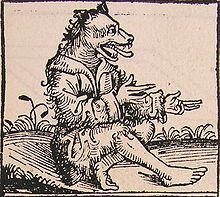
Nature for Pliny was divine, a pantheistic concept inspired by the Stoic philosophy, which underlies much of his thought, but the deity in question was a goddess whose main purpose was to serve the human race: "nature, that is life" is human life in a natural landscape. After an initial survey of cosmology and geography, Pliny starts his treatment of animals with the human race, "for whose sake great Nature appears to have created all other things".[8] This teleological view of nature was common in antiquity and is crucial to the understanding of the Natural History.[9] The components of nature are not just described in and for themselves, but also with a view to their role in human life. Pliny devotes a number of the books to plants, with a focus on their medicinal value; the books on minerals include descriptions of their uses in architecture, sculpture, art, and jewellery. Pliny's premise is distinct from modern ecological theories, reflecting the prevailing sentiment of his time.[10]
Pliny's work frequently reflects Rome's imperial expansion, which brought new and exciting things to the capital: exotic eastern spices, strange animals to be put on display or herded into the arena, even the alleged
"As full of variety as nature itself",
The Natural History was one of the first ancient European texts to be printed, in Venice in 1469.[15] Philemon Holland's English translation of 1601 has influenced literature ever since.[15]
Structure
The Natural History consists of 37 books. Pliny devised a summarium, or list of contents, at the beginning of the work that was later interpreted by modern printers as a table of contents.[16] The table below is a summary based on modern names for topics.
| Volume | Books | Contents |
|---|---|---|
| I | 1 | Preface and list of contents, lists of authorities |
| 2 | Astronomy, meteorology | |
| II | 3–6 | Geography and ethnography |
| 7 | Anthropology and human physiology | |
| III | 8–11 | Zoology, including mammals, snakes, marine animals, birds, insects |
| IV–VII | 12–27 | Botany, including agriculture, horticulture, especially of the vine and olive, medicine |
| VIII | 28–32 | magic, water , aquatic life
|
| IX–X | 33–37 | Mining and mineralogy, especially as applied to life and art, work in gold and silver,[17] statuary in bronze,[18] art,[19] modelling,[20] sculpture in marble,[21] precious stones and gems[22] |
Production
Purpose
Pliny's purpose in writing the Natural History was to cover all learning and art so far as they are connected with nature or draw their materials from nature.[4] He says:[3]
My subject is a barren one – the world of nature, or in other words life; and that subject in its least elevated department, and employing either rustic terms or foreign, nay barbarian words that actually have to be introduced with an apology. Moreover, the path is not a beaten highway of authorship, nor one in which the mind is eager to range: there is not one of us who has made the same venture, nor yet one among the Greeks who has tackled single-handed all departments of the subject.
Sources
Pliny studied the original authorities on each subject and took care to make excerpts from their pages. His indices auctorum sometimes list the authorities he actually consulted, though not exhaustively; in other cases, they cover the principal writers on the subject, whose names are borrowed second-hand from his immediate authorities.[4] He acknowledges his obligations to his predecessors: "To own up to those who were the means of one's own achievements."[23]
In the preface, the author claims to have stated 20,000 facts gathered from some 2,000 books and from 100 select authors.[24] The extant lists of his authorities cover more than 400, including 146 Roman and 327 Greek and other sources of information. The lists generally follow the order of the subject matter of each book. This has been shown in Heinrich Brunn's Disputatio (Bonn, 1856).[4][25]
One of Pliny's authorities is
Working method
His nephew, Pliny the Younger, described the method that Pliny used to write the Natural History:[27]
Does it surprise you that a busy man found time to finish so many volumes, many of which deal with such minute details?... He used to begin to study at night on the
Festival of Vulcan, not for luck but from his love of study, long before dawn; in winter he would commence at the seventh hour... He could sleep at call, and it would come upon him and leave him in the middle of his work. Before daybreak he would go to Vespasian – for he too was a night-worker – and then set about his official duties. On his return home he would again give to study any time that he had free. Often in summer after taking a meal, which with him, as in the old days, was always a simple and light one, he would lie in the sun if he had any time to spare, and a book would be read aloud, from which he would take notes and extracts.
Pliny the Younger told the following anecdote illustrating his uncle's enthusiasm for study:[27]
After dinner a book would be read aloud, and he would take notes in a cursory way. I remember that one of his friends, when the reader pronounced a word wrongly, checked him and made him read it again, and my uncle said to him, "Did you not catch the meaning?" When his friend said "yes," he remarked, "Why then did you make him turn back? We have lost more than ten lines through your interruption." So jealous was he of every moment lost.
Style
Pliny's writing style emulates that of
dixit (Apelles) ... uno se praestare, quod manum de tabula sciret tollere, memorabili praecepto nocere saepe nimiam diligentiam.[4]
This might be translated
In one thing Apelles stood out, namely, knowing when he had put enough work into a painting, a salutary warning that too much effort can be counterproductive.[31]
Everything from "a salutary warning" onwards represents the ablative absolute phrase starting with "memorabili praecepto".
Publication history
First publication
Pliny wrote the first ten books in AD 77, and was engaged on revising the rest during the two remaining years of his life. The work was probably published with little revision by the author's nephew Pliny the Younger, who, when telling the story of a tame dolphin and describing the
The absence of the author's final revision may explain many errors,[4] including why the text is as John Healy writes "disjointed, discontinuous and not in a logical order";[35] and as early as 1350, Petrarch complained about the corrupt state of the text, referring to copying errors made between the ninth and eleventh centuries.[36]
Manuscripts

About the middle of the 3rd century, an abstract of the geographical portions of Pliny's work was produced by
There are about 200 extant manuscripts, but the best of the more ancient manuscripts, that at Bamberg State Library, contains only books XXXII–XXXVII. In 1141 Robert of Cricklade wrote the Defloratio Historiae Naturalis Plinii Secundi consisting of nine books of selections taken from an ancient manuscript.[4][38]
Printed copies
The work was one of the first classical manuscripts to be
Translations
Topics
The Natural History is generally divided into the organic plants and animals and the inorganic matter, although there are frequent digressions in each section.[b] The encyclopedia also notes the uses made of all of these by the Romans. Its description of metals and minerals is valued for its detail in the history of science, being the most extensive compilation still available from the ancient world.
Book I serves as Pliny's preface, explaining his approach and providing a table of contents.
Astronomy

The first topic covered is Astronomy, in Book II. Pliny starts with the known universe, roundly criticising attempts at cosmology as madness, including the view that there are countless other worlds than the Earth. He concurs with the four (Aristotelian) elements, fire, earth, air and water,[42] and records the seven "planets" including the Sun and Moon.[43] The Earth is a sphere, suspended in the middle of space.[44] He considers it a weakness to try to find the shape and form of God,[45] or to suppose that such a being would care about human affairs.[46] He mentions eclipses, but considers Hipparchus's almanac grandiose for seeming to know how Nature works.[47] He cites Posidonius's estimate that the Moon is 230,000 miles away.[c] He describes comets, noting that only Aristotle has recorded seeing more than one at once.[48]
Book II continues with natural meteorological events lower in the sky, including the winds, weather, whirlwinds, lightning, and rainbows.[49] He returns to astronomical facts such as the effect of longitude on time of sunrise and sunset,[50] the variation of the Sun's elevation with latitude (affecting time-telling by sundials),[51] and the variation of day length with latitude.[52]
Geography
In Books III to VI, Pliny moves to the Earth itself. In Book III he covers the geography of the Iberian peninsula and Italy; Book IV covers Europe including Britain; Book V looks at Africa and Asia, while Book VI looks eastwards to the Black Sea, India and the Far East.
Anthropology
Book VII discusses the human race, covering anthropology and ethnography, aspects of human physiology and assorted matters such as the greatness of Julius Caesar, outstanding people such as Hippocrates and Asclepiades, happiness and fortune.
Zoology
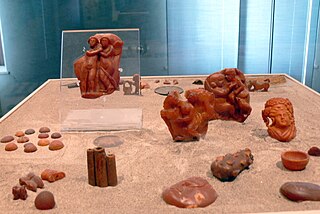
Zoology is discussed in Books VIII to XI. The encyclopedia mentions different sources of purple dye, particularly the murex snail, the highly prized source of Tyrian purple. It describes the elephant and hippopotamus in detail, as well as the value and origin of the pearl and the invention of fish farming and oyster farming. The keeping of aquariums was a popular pastime of the rich, and Pliny provides anecdotes of the problems of owners becoming too closely attached to their fish.
Pliny correctly identifies the origin of
Botany
Botany is handled in Books XII to XVIII, with Theophrastus as one of Pliny's sources. The manufacture of papyrus and the various grades of papyrus available to Romans are described. Different types of trees and the properties of their wood are explained in Books XII to XIII. The vine, viticulture and varieties of grape are discussed in Book XIV, while Book XV covers the olive tree in detail,[53] followed by other trees including the apple and pear,[54] fig,[55] cherry,[56] myrtle and laurel,[57] among others.
Pliny gives special attention to spices, such as
He is critical of
Drugs, medicine and magic
A major section of the Natural History, Books XX to XXIX, discusses matters related to medicine, especially plants that yield useful drugs. Pliny lists over 900 drugs, compared to 600 in
The poppy and opium are mentioned; Pliny notes that opium induces sleep and can be fatal.[59] Diseases and their treatment are covered in book XXVI.Pliny addresses
Agriculture
The methods used to cultivate crops are described in Book XVIII. He praises
Metallurgy
Pliny extensively discusses metals starting with gold and silver (Book XXXIII), and then the base metals copper, mercury, lead, tin and iron, as well as their many alloys such as electrum, bronze, pewter, and steel (Book XXXIV).
He is critical of greed for gold, such as the absurdity of using the metal for coins in the early Republic. He gives examples of the way rulers proclaimed their prowess by exhibiting gold looted from their campaigns, such as that by Claudius after conquering Britain, and tells the stories of

Fraud and forgery are described in detail; in particular
The main ore of mercury is
Pliny gives a special place to iron, distinguishing the hardness of steel from what is now called wrought iron, a softer grade. He is scathing about the use of iron in warfare.
Mineralogy
In the last two books of the work (Books XXXVI and XXXVII), Pliny describes many different
Pliny moves into
Pliny returns to the problem of fraud and the detection of false gems using several tests, including the scratch test, where counterfeit gems can be marked by a steel file, and genuine ones not. Perhaps it refers to glass imitations of jewellery gemstones. He refers to using one hard mineral to scratch another, presaging the
Art history
Pliny's chapters on Roman and Greek art are especially valuable because his work is virtually the only available classical source of information on the subject.[65]
In the
Greek epigrams contribute their share in Pliny's descriptions of pictures and statues. One of the minor authorities for books XXXIV–XXXV is Heliodorus of Athens, the author of a work on the monuments of Athens. In the indices to XXXIII–XXXVI, an important place is assigned to Pasiteles of Naples, the author of a work in five volumes on famous works of art (XXXVI:40), probably incorporating the substance of the earlier Greek treatises; but Pliny's indebtedness to Pasiteles is denied by Kalkmann, who holds that Pliny used the chronological work of Apollodorus of Athens, as well as a current catalogue of artists. Pliny's knowledge of the Greek authorities was probably mainly due to Varro, whom he often quotes (e.g. XXXIV:56, XXXV:113, 156, XXXVI:17, 39, 41).[4]
For a number of items relating to works of art near the coast of
In several passages, he gives proof of independent observation (XXXIV:38, 46, 63, XXXV:17, 20, 116 seq.). He prefers the marble , Athenodoros (possibly son of Agesander) and Polydorus.
In the temple near the
At Rome indeed the works of art are legion; besides, one effaces another from the memory and, however beautiful they may be, we are distracted by the overpowering claims of duty and business; for to admire art we need leisure and profound stillness[4] (XXXVI:27).
Mining
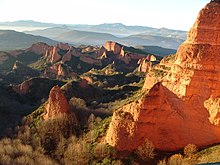
Pliny provides lucid descriptions of
Book XXXIV covers the base metals, their uses and their extraction. Copper mining is mentioned, using a variety of ores including
Reception
Medieval and early modern
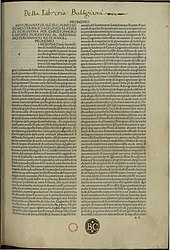
The anonymous fourth-century compilation Medicina Plinii contains more than 1,100 pharmacological recipes, the vast majority of them from the Historia naturalis; perhaps because Pliny's name was attached to it, it enjoyed huge popularity in the Middle Ages.[73]
Isidore of Seville's Etymologiae (The Etymologies, c. 600–625) quotes from Pliny 45 times in Book XII alone;[74] Books XII, XIII and XIV are all based largely on the Natural History.[75][76] Through Isidore, Vincent of Beauvais's Speculum Maius (The Great Mirror, c. 1235–1264) also used Pliny as a source for his own work.[77][78] In this regard, Pliny's influence over the medieval period has been argued to be quite extensive. For example, one twentieth-century historian has argued that Pliny's reliance on book-based knowledge, and not direct observation, shaped intellectual life to the degree that it "stymie[d] the progress of western science".[79] This sentiment can be observed in the early modern period when Niccolò Leoniceno's 1509 De Erroribus Plinii ("On Pliny's Errors") attacked Pliny for lacking a proper scientific method, unlike Theophrastus or Dioscorides, and for lacking knowledge of philosophy or medicine.[15]
Sir Thomas Browne expressed scepticism about Pliny's dependability in his 1646 Pseudodoxia Epidemica:[80]
Now what is very strange, there is scarce a popular error passant in our days, which is not either directly expressed, or diductively contained in this Work; which being in the hands of most men, hath proved a powerful occasion of their propagation. Wherein notwithstanding the credulity of the Reader is more condemnable then the curiosity of the Author: for commonly he nameth the Authors from whom he received those accounts, and writes but as he reads, as in his Preface to Vespasian he acknowledgeth.
Modern
Grundy Steiner of Northwestern University, in a 1955 judgement considered by Thomas R. Laehn to represent the collective opinion of Pliny's critics,[81] wrote of Pliny that "He was not an original, creative thinker, nor a pioneer of research to be compared either with Aristotle and Theophrastus or with any of the great moderns. He was, rather, the compiler of a secondary sourcebook."[82]
The Italian author Italo Calvino, in his 1991 book Why Read the Classics?, wrote that while people often consult Pliny's Natural History for facts and curiosities, he is an author who "deserves an extended read, for the measured movement of his prose, which is enlivened by his admiration for everything that exists and his respect for the infinite diversity of all phenomena".[83] Calvino notes that while Pliny is eclectic, he was not uncritical, though his evaluations of sources are inconsistent and unpredictable. Further, Calvino compares Pliny to Immanuel Kant, in that God is prevented by logic from conflicting with reason, even though (in Calvino's view) Pliny makes a pantheistic identification of God as being immanent in nature. As for destiny, Calvino writes:
it is impossible to force that variable which is destiny into the natural history of man: this is the sense of the pages that Pliny devotes to the vicissitudes of fortune, to the unpredictability of the length of any life, to the pointlessness of astrology, to disease and death.[83]
The art historian Jacob Isager writes in the introduction to his analysis of Pliny's chapters on art in the Natural History that his intention is:
to show how Pliny in his encyclopedic work – which is the result of adaptations from many earlier writers and according to Pliny himself was intended as a reference work – nevertheless throughout expresses a basic attitude to Man and his relationship with Nature; how he understands Man's role as an inventor ("scientist and artist"); and finally his attitude to the use and abuse of Nature's and Man's creations, to progress and decay.[65]
More specifically, Isager writes that "the guiding principle in Pliny's treatment of Greek and Roman art is the function of art in society",[65] while Pliny "uses his art history to express opinions about the ideology of the state".[65] Paula Findlen, writing in the Cambridge History of Science, asserts that
Natural history was an ancient form of scientific knowledge, most closely associated with the writings of the Roman encyclopedist Pliny the Elder ... His loquacious and witty Historia naturalis offered an expansive definition of this subject. [It] broadly described all entities found in nature, or derived from nature, that could be seen in the Roman world and read about in its books: art, artifacts, and peoples as well as animals, plants, and minerals were included in his project.
De Materia Medica.[84]In the view of Mary Beagon, writing in The Classical Tradition in 2010:the Historia naturalis has regained its status to a greater extent than at any time since the advent of Humanism. Work by those with scientific as well as philological expertise has resulted in improvements both to Pliny's text and to his reputation as a scientist. The essential coherence of his enterprise has also been rediscovered, and his ambitious portrayal, in all its manifestations, of 'nature, that is, life'.. is recognized as a unique cultural record of its time.[85]
See also
- Famulus – his biography is featured in Natural History
- Naturales quaestiones – a similar, shorter encyclopedia written by Seneca
- Suda – a 10th century Byzantine encyclopedia
Notes
- ^ Cf. Pliny's consideration of Aristotle, as well as modern criticism of Pliny's work, in Trevor Murphy, Pliny the Elder's Natural History: The Empire in the Encyclopedia, OUP (2004), pp. 1–27, 194–215.
- ^ Compare structure at LacusCurtius, with footnotes.
- ^ John Gerard's influential Herball (1597) called scolecium "Maggot berrie" and supposed "Cutchonele" (Cochineal) to be a form of this. Many later authors have copied Gerard in this error.[60]
- ^ It is likely that Pliny, as a Procurator in Hispania Tarraconensis, saw the operations of gold extraction himself, since the sections in Book XXXIII read like an eye witness report.
- ^ See David Bird's analysis of Pliny's use of water power in mining.[68]
- ^ This probably refers to opencast rather than underground mining, given the dangers to the miners in confined spaces.
- ^ "...est namque terra ex quodam argillae genere glarea mixta – 'gangadiam' vocant – prope inexpugnabilis. cuneis eam ferreis adgrediuntur et isdem malleis nihilque durius putant, nisi quod inter omnia auri fames durissima est [...]"[69]
- ^ See also Bird on mining at Arrugia.[68]
References
- ^ Healy, 2004. p. xix, citing Pliny's Preface, 6: "It is written for the masses, for the horde of farmers and artisans".
- ^ Natural History I:13
- ^ a b c Natural History. Dedication to Titus: C. Plinius Secundus to his Friend Titus Vespasian
- ^ a b c d e f g h i j k l m n o p One or more of the preceding sentences incorporates text from a publication now in the public domain: Sandys, John Edwin (1911). "Pliny the Elder". In Chisholm, Hugh (ed.). Encyclopædia Britannica. Vol. 21 (11th ed.). Cambridge University Press. pp. 841–844.
- ^ Natural History XXXVII:77
- ^ "Introduction" to Natural History, Bks. I–II, Loeb Classical Library (rev. ed. 1989), pp. vii-x.
- ^ Natural History VIII:44 (Loeb)
- ^ Natural History VII:1 (Rackham et al.)
- ^ Natural History VII
- ^ "Introduction" to Natural History, Books III-VII, Loeb Classical Library (rev. ed. 1989), pp. xi-xiii.
- ^ Natural History XI:2 (Rackham et al.)
- ^ Natural History VII:2
- ^ Pliny the Younger, Letters, 3.5
- ^ Pliny the Younger, Letters, 6.16
- ^ a b c d e Healy, 2004. Introduction:xxxix
- ^ Doody 2010, p. 9.
- ^ Natural History XXXIII:154–751
- ^ Natural History XXXIV
- ^ Natural History XXXV:15–941
- ^ Natural History XXXV:151–851
- ^ Natural History XXXVI
- ^ Natural History XXXVII
- ^ Pliny the Elder. Praefatio:21
- ^ Cf. Heinrich Brunn's Kleine Schriften Gesammelt Von Hermann Brunn Und Heinrich Bulle...: Bd. Zur Griechischen Kunstgeschichte. Mit 69 Abbildungen Im Text Und Auf Einer Doppeltafel, 1905 reproduction by Ulan Press (2012).
- ^ Cf. Mary Beagon, Roman Nature: The Thought of Pliny the Elder, Clarendon Press (1992), s.v.; Trevor Murphy, Pliny the Elder's Natural History: The Empire in the Encyclopedia, OUP (2004), pp. 196–200 and passim.
- ^ a b Pliny the Younger. Book 3, Letter V. To Baebius Macer. in "Letters of Pliny the Younger" with introduction by John B. Firth.
- ^ Cf. Trevor Murphy, Pliny the Elder's Natural History: The Empire in the Encyclopedia, OUP (2004), pp. 181–197.
- ^ Cf. P. L. Chambers, The Natural Histories of Pliny the Elder: An Advanced Reader and Grammar Review, University of Oklahoma Press (2012), s.v., and Latin syntax in Pliny; see also Roger French & Frank Greenaway, Science in the Early Roman Empire: Pliny the Elder, his Sources and Influence, Croom Helm (1986), pp. 23–44.
- ^ Natural History XXXV:80
- ^ Healy, 2004. page 331 (translation of XXXV:80
- ^ Pliny the Younger, Letters, 8.20, 9.33
- ^ Pliny the Elder. "II:209, IX:26". Natural History.
- ^ Pliny the Younger, Letters, 3.5; see also The True Story of Lake Vadimo (in Italian).
- ^ Healy, 2004. Translator's Note:xliii
- ^ Healy, 2004. Introduction:xxxviii-xxxix
- ^ Healy, 2004. Introduction:xxxvi-xxxvii
- ^ Healy, 2004. Introduction:xxxviii
- .
- ^ Holland, Philemon (1601). "The Historie of the World, Commonly called, The Naturall Historie of C. Plinius Secundus". University of Chicago. Retrieved 28 May 2015.
- ^ Bostock, John; Riley, H. T. (1855). "Pliny the Elder, The Natural History". Perseus at Tufts. Retrieved 28 May 2015.
- ^ Natural History II:11
- ^ Natural History II:28-51
- ^ Natural History II:5-6, 10
- ^ Natural History II:14
- ^ Natural History II:20
- ^ Natural History II:24
- ^ Natural History I:89-90
- ^ Natural History II:119-153
- ^ Natural History II:181
- ^ Natural History II:182
- ^ Natural History II:186-187
- ^ Natural History XV:1-34
- ^ Natural History XV:47-54
- ^ Natural History XV:68-78
- ^ Natural History XV:102-104
- ^ Natural History XV:119-138
- ^ Healy, 2004. Introduction:xxix
- ^ Natural History XX:198-200
- ^ Greenfield, Amy Butler (2011). A Perfect Red: Empire, Espionage and the Quest for the Colour of Desire. Random House. p. 351.
- ^ Natural History XXXVII:18-22
- ^ Natural History XXXVII:55-60
- ^ Natural History XXXVII:23-29
- ^ Natural History XXXVII:196-200
- ^ a b c d Isager, Jacob (2013). Pliny on Art and Society: The Elder Pliny's Chapters on the History of Art. Routledge. p. 16.
- ^ Natural History XXXIII:36-81
- ^ a b "Pliny's Arrugia Water Power in Roman Gold-Mining" Archived 28 March 2012 at the Wayback Machine, by David Bird, in Mining History Vol. 15, Nos. 4/5 (2004).
- ^ N.H. xxi-72.
- ^ Natural History XXXIV:117
- ^ Natural History XXXIII:138-144
- ^ Natural History XXXIII:156-164
- ^ D.R. Langlow, Medical Latin in the Roman Empire (Oxford University Press, 2000), p. 64.
- ^ Lindsay, Wallace M. (1911). Isidori Hispalensis Episcopi Etymologiarum Sive Originum Libri XX. Clarendon Press.
- ^ Doody 2010, p. 170.
- ^ Doody 2010, p. 31.
- ^ Available at the [1] University of Chicago site
- ^ Laehn, Thomas R (2013). Pliny's Defense of Empire. Routledge. p. 111.
- ^
ISBN 978-0-14-118970-3.(First published as Perché leggere i classici, Mondadori, 1991.- ^ )
- ^ Beagon, Mary (2010). "Pliny the Elder". In Grafton, Anthony; Most, Glenn W.; Settis, Salvatore (eds.). The Classical Tradition. Harvard University Press. p. 745.
Sources
- French, Roger & Greenaway, Frank (1986). Science in the Early Roman Empire: Pliny the Elder, his Sources and Influence. Croom Helm.
- Gibson, Roy; Morello, Ruth, eds. (2011). Pliny the Elder: Themes and Contexts. Brill.
- Doody, Aude (2010). Pliny's encyclopedia : the reception of the Natural history. Cambridge University Press.
ISBN 978-0-511-67707-6.- Healy, John F. (1999). Pliny the Elder on Science and Technology. Oxford University Press.
ISBN 0-19-814687-6.- Healy, John F. (2004). Pliny the Elder: Natural History: A Selection. Penguin Classics.
ISBN 978-0-14-044413-1.- Isager, Jacob (1991). Pliny on Art and Society: The Elder Pliny's Chapters on the History of Art. London & New York: Routledge.
ISBN 0-415-06950-5.- Jones, R. F. J.; Bird, D. G. (1972). "Roman gold-mining in north-west Spain, II: Workings on the Rio Duerna". Journal of Roman Studies. 62. Society for the Promotion of Roman Studies: 59–74.
S2CID 162096359.- Lewis, P. R.; Jones, G. D. B. (1970). "Roman gold-mining in north-west Spain". Journal of Roman Studies. 60. The Journal of Roman Studies, Vol. 60: 169–85.
JSTOR 299421.- Naas, Valérie (2023). Anecdotes artistiques chez Pline l'Ancien: La constitution d'un discours romain sur l'art. Paris: Sorbonne Université Presses.
ISBN 9791023107432.- Parejko, Ken (2009). "Pliny the Elder – Rampant Credulist, Rational Skeptic, or Both?". Skeptical Inquirer. 27 (1): 39.
- Pliny – Natural History, 10 volumes. Translated by Rackham, H.; Jones, W. H. S.; Eichholz, D. E. Loeb Classical Library. 1938–1962.
- Wethered, H. N. (1937). The Mind of the Ancient World: A Consideration of Pliny's Natural History. London: Longmans Green.
External links
Latin Wikisource has original text related to this article:Wikisource has original text related to this article:Wikimedia Commons has media related to Naturalis Historia.Primary
Latin
- Complete Latin text at LacusCurtius
- Complete Latin text with translation tools at Perseus Digital Library
- Naturalis Historia. Pliny the Elder. Johannes de Spira. Venice. before 18 September 1469. at Corning Museum of Glass. (Once owned by the Earls of Pembroke)
- Naturalis Historia. Pliny the Elder. Karl Friedrich Theodor Mayhoff. Lipsiae. Teubner. 1906.
English
- First English translation, by Philemon Holland, 1601
- Second English translation, by John Bostock and Henry Thomas Riley, 1855; complete, with index
The Natural History public domain audiobook at LibriVox
- Pliny's Natural History Translated by H. Rackham (vols. 1–5, 9) and W.H.S. Jones (vols. 6–8) and D.E. Eichholz (vol. 10) Harvard University Press, Massachusetts and William Heinemann, London; 1949–1954.
- All Six Volumes free at Project Gutenberg
Italian
- Historia naturalis (in Italian). Venezia: Bartolomeo Zani. 1489.
Secondary

